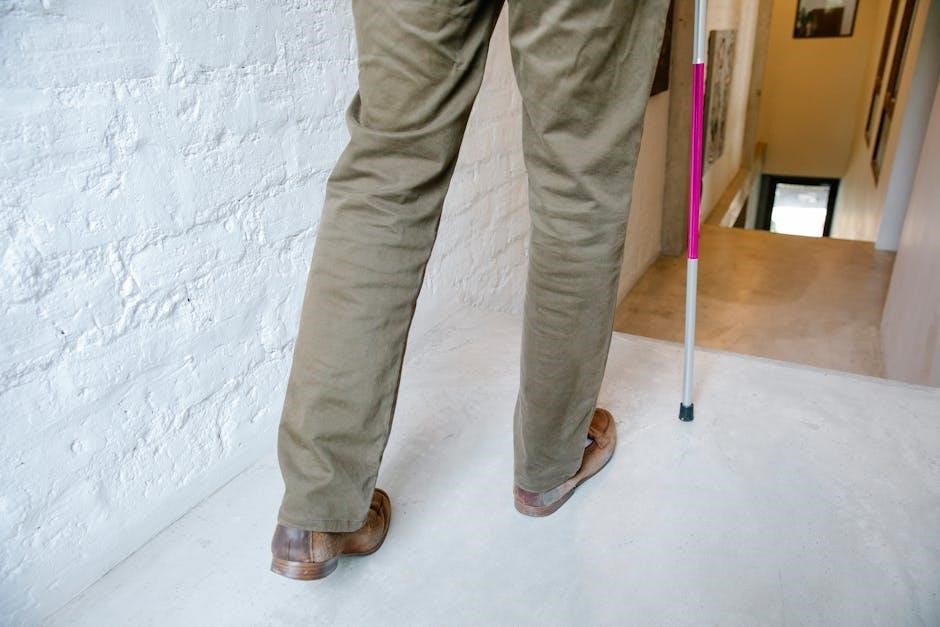
Welcome to the Kwikee Step Troubleshooting Guide. This guide helps RVers troubleshoot and resolve issues like retraction, motor faults, and electrical problems. Regular maintenance is key.
Overview of Kwikee Steps and Their Importance in RVs
Kwikee Steps are electrically powered RV steps designed for convenience and durability. They provide easy access in and out of recreational vehicles, enhancing safety and comfort. These steps are a vital component for RVers, offering a reliable solution for entering and exiting the vehicle. Their electric operation ensures smooth functionality, while their sturdy construction withstands various weather conditions. Kwikee Steps are a standard feature in many RVs due to their efficiency and user-friendly design. They play a crucial role in improving the overall RVing experience, especially for those with mobility challenges. Regular maintenance is essential to ensure optimal performance and longevity.
Common Issues Faced by Kwikee Step Users
Kwikee Steps, while reliable, can encounter issues like retraction problems, motor malfunctions, and electrical faults. Users often face challenges with steps not retracting fully or binding during closure. Motors may run continuously after steps are fully extended or retracted, indicating potential controller issues. Some users report steps operating in reverse, where opening the door closes the steps and vice versa. Electrical failures, faulty wiring, or misaligned components can also cause irregular behavior. Understanding these common issues is crucial for effective troubleshooting and maintaining optimal step performance. This guide addresses these problems and provides practical solutions to ensure your Kwikee Steps function smoothly.

Step Retraction Problems
Step retraction issues are common, often caused by mechanical or electrical faults. Troubleshooting involves checking for obstructions, worn parts, or wiring problems to ensure proper function.

Troubleshooting Steps That Won’t Retract Fully
If your Kwikee steps fail to retract fully, start by inspecting for obstructions or debris hindering movement. Check the step alignment and ensure all bolts are secure. Worn or damaged parts, such as the gearbox or motor, may require replacement. Electrical issues, like faulty switches or wiring, can also prevent proper retraction. Consult the parts diagram to identify components needing attention. Lubricate moving parts and test the system after repairs. If problems persist, consider professional assistance to ensure safe and reliable operation of your RV steps.
Addressing Binding Issues During Step Closure
Binding during step closure can occur due to misalignment, debris, or worn parts. Inspect the steps for obstructions and clean thoroughly. Check the alignment of the steps and ensure proper connection to the motor. Lubricate hinges and moving parts to reduce friction. If binding persists, examine the gearbox and motor for wear. Replace any damaged components to restore smooth operation. Ensure all bolts and screws are tightened securely. If issues remain, consult the parts diagram for further diagnosis or consider professional assistance to prevent further damage and ensure safe functionality of your Kwikee steps.
Replacing the Motor and Gearbox: When to Take Action
Replace the motor and gearbox if they show signs of failure, such as unusual noises, slow operation, or steps not moving at all. Ensure compatibility with your specific Kwikee model. Turn off the power supply before starting. Disconnect wiring and mounting hardware carefully. Install the new motor and gearbox, following the manufacturer’s instructions. Test the steps to ensure proper function. If unsure, consult a professional to avoid further damage. Regular maintenance can prevent premature wear, ensuring reliable performance and safety.
Motor and Gearbox Troubleshooting
Identify motor and gearbox issues by checking for unusual noises, erratic movement, or continuous running. Inspect for obstructions, worn components, or faulty controllers that may cause malfunctions.
Why the Motor Might Continue Running After Steps Are Fully Opened or Closed
The motor may continue running due to a faulty controller or wiring issues. Check for obstructions preventing full closure, ensuring steps are clear. Verify wiring connections and test the controller for proper signal termination. If issues persist, replace the controller or consult a professional. Regular maintenance can prevent such malfunctions.
Identifying Faulty Controllers and Finding Replacements
Faulty controllers can cause irregular step operation. Look for signs like continuous motor running or steps reversing direction. Check the controller model, such as the LC363980, and ensure it matches your Kwikee step model. For replacements, consult etrailer.com or contact Kwikee directly. Proper installation is crucial to avoid further issues. Always verify compatibility before purchasing. If unsure, seek professional assistance for accurate diagnosis and installation. Regular checks can prevent controller failure and ensure smooth step operation. Replacing a faulty controller promptly avoids additional damage to the motor or gearbox. Keep your RV steps functioning reliably with the right replacement parts.
Reverse Operation of Steps: Causes and Solutions
Reverse operation occurs when Kwikee steps move inward when they should extend and vice versa. This issue often arises from incorrect wiring or a faulty controller. Check the wiring connections to ensure they are properly secured and not crossed. If the problem persists, inspect the controller for damage or misconfiguration. A faulty controller may need replacement. Ensure the new controller is compatible with your step model. If unsure, consult the parts diagram or contact Kwikee support. Correcting the wiring or replacing the controller typically resolves the issue. For complex cases, professional assistance is recommended to avoid further damage. Always test the steps after repairs to confirm proper operation.

Electrical and Wiring Issues
Diagnose electrical failures by checking connections and fuses. Faulty controllers or wiring can cause steps to malfunction. Consult wiring diagrams to identify and repair issues promptly.
Diagnosing Electrical Failures in Kwikee Steps
Diagnosing electrical failures in Kwikee steps involves checking the power source, wiring, and controllers. Start by ensuring the battery is fully charged and connections are secure. Inspect wiring for damage or corrosion, as these can disrupt step operation. Use a multimeter to test voltage at the motor and controller. If the motor runs continuously, the controller may be faulty. Review wiring diagrams to trace connections and identify short circuits. Common issues include faulty relays, blown fuses, or miswired components. Addressing electrical faults promptly prevents further damage and ensures reliable step performance.
Understanding the Role of Controllers in Step Operation
Controllers play a crucial role in Kwikee step operation by regulating the motor and gearbox functions. They manage the electrical signals that control step extension and retraction. The controller ensures smooth operation by interpreting inputs from switches and sensors. If the controller malfunctions, it can cause issues like continuous motor operation or reverse step movement. Replacing a faulty controller with the correct model, such as the LC363980 for Revolution Steps, is essential. Always verify compatibility with your step model to maintain proper functionality and safety. Proper controller installation and wiring are vital to avoid operational disruptions and ensure reliable performance.
Wiring Diagrams and Connections: Common Mistakes
Improper wiring is a frequent issue in Kwikee step malfunctions. Common mistakes include incorrect connections between the motor, controller, and sensors. Misaligned wires can cause the motor to run continuously or fail to respond. Always refer to the wiring diagram specific to your step model. Loose connections or corroded terminals can disrupt operation. Ensure all wires are securely attached and terminals are clean. Crossing or pinching wires during installation can lead to short circuits. Properly routing and securing wires prevents damage. Double-checking connections against the diagram helps avoid errors. Correct wiring ensures smooth operation and prevents electrical failures, enhancing overall step reliability and longevity.

Parts Diagram and Replacement
Understanding the Kwikee Step parts diagram is essential for accurate troubleshooting and replacement. This section covers identifying components and finding the right replacements efficiently.
Understanding the Kwikee Step Parts Diagram
The Kwikee Step parts diagram provides a detailed visual breakdown of all components, from motors to gears. This guide helps users identify each part, ensuring accurate troubleshooting and replacement. It highlights connections between electrical and mechanical systems, making diagnosis easier. By referencing the diagram, RVers can pinpoint issues without guessing, saving time and effort. Understanding the layout and function of each part is crucial for effective repairs and maintaining step performance over time. Regular review of the diagram can enhance familiarity, making future troubleshooting more efficient and less overwhelming for RV owners. This tool is indispensable for proper step maintenance and operation.
Essential Parts for Troubleshooting: What to Look For
When troubleshooting Kwikee steps, focus on critical components like the motor, gearbox, and controller. The motor powers the steps, while the gearbox ensures smooth operation. A faulty controller can disrupt signals, causing malfunctions. Check for worn or damaged gears, as they can bind or fail to engage properly. Electrical connections and wiring should also be inspected for corrosion or damage. Additionally, ensure the step arms and hinges are aligned and lubricated. Identifying these essential parts helps pinpoint issues quickly, whether it’s a mechanical failure or an electrical problem. Regular inspection of these components is key to preventing breakdowns and ensuring reliable step performance.

Maintenance and Prevention
Regular lubrication of hinges and gears prevents binding. Clean debris from steps to ensure smooth operation. Inspect electrical connections for corrosion to avoid malfunctions.
Regular Maintenance Tips to Avoid Step Malfunctions
Regular maintenance is crucial for Kwikee steps. Start by lubricating all moving parts, including hinges, gears, and linkages, to prevent friction and wear. Next, inspect the steps for debris and clean them thoroughly. Check electrical connections for corrosion and ensure they are secure. Tighten any loose bolts or screws, as vibrations can cause hardware to loosen over time. Finally, test the steps’ operation by opening and closing them several times to ensure smooth movement. By following these tips, you can extend the lifespan of your Kwikee steps and avoid common issues.
Cleaning and Lubricating Kwikee Steps
Cleaning and lubricating Kwikee steps are essential for optimal performance. Start by removing dirt and debris with a soft brush or cloth. Use a mild detergent to wipe down surfaces, avoiding harsh chemicals. Next, apply a silicone-based lubricant to hinges, gears, and linkages to reduce friction. Ensure electrical connections are clean and free of corrosion using a wire brush and electrical cleaner. After lubricating, test the steps by opening and closing them several times to ensure smooth operation. Regular cleaning and lubrication prevent malfunctions and extend the lifespan of your Kwikee steps. Perform this maintenance every 3 to 6 months or as needed.

Advanced Troubleshooting Techniques

Advanced troubleshooting involves using diagnostic tools like multimeters for electrical issues and recognizing when professional assistance is necessary for complex mechanical or electrical problems.
Using Diagnostic Tools for Kwikee Steps
Diagnostic tools are essential for identifying issues in Kwikee steps. A multimeter can check for electrical shorts or voltage drops in wiring. Circuit testers help verify proper connections and power flow. inspecting the motor and gearbox with specialized tools ensures mechanical integrity. Wiring diagrams are crucial for tracing circuits and identifying faults. Advanced tools likecontrollers testers can pinpoint faulty components. Regular use of these tools helps troubleshoot issues efficiently, reducing downtime and ensuring safe operation.
When to Seek Professional Assistance
If basic troubleshooting steps fail to resolve your Kwikee step issues, it may be time to seek professional help. This is especially true for complex problems like persistent motor malfunctions or electrical system faults. A qualified technician can diagnose and repair intricate issues beyond DIY fixes. Additionally, if you encounter safety concerns, such as steps not functioning properly or causing instability, professional assistance is essential. Don’t hesitate to consult a specialist if you’re unsure about performing advanced repairs or if the problem persists after trying recommended solutions. Professional guidance ensures reliability and safety, preventing further damage or potential accidents.
Successful troubleshooting and maintenance of Kwikee steps ensure reliability and safety. Addressing issues like retraction problems, motor faults, and wiring ensures optimal performance. Regular maintenance is crucial.
Troubleshooting Kwikee steps involves diagnosing common issues like retraction problems, motor faults, and electrical failures. Start by checking for binding or obstructions during step closure. Inspect electrical connections and controllers for damage or corrosion. If steps reverse or the motor runs continuously, suspect a faulty controller or wiring issue. Replace worn or damaged parts, such as the motor or gearbox, if necessary. Regular maintenance, including cleaning and lubricating moving parts, can prevent malfunctions. Always refer to the parts diagram for accurate repairs. If unresolved, consult diagnostic tools or seek professional assistance to ensure long-term performance and safety.
Final Tips for Long-Term Step Performance
For optimal performance, maintain your Kwikee steps with regular lubrication of moving parts and thorough cleaning to remove debris. Address issues promptly to prevent minor problems from escalating. Use genuine Kwikee replacement parts for reliability and compatibility. Monitor motor operation for unusual noises or behaviors, as these can signal underlying issues. Keep wiring and connections secure to avoid electrical faults. Finally, consult the user manual for specific maintenance schedules and guidelines tailored to your model. By following these tips, you can ensure your Kwikee steps function smoothly and safely for years to come.